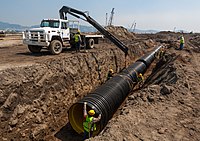
Photo from wikipedia
Abstract The functional decline of subsurface drainage systems has become a problem for the cultivation of upland crops in rotational paddy fields, necessitating the development of methods to determine its… Click to show full abstract
Abstract The functional decline of subsurface drainage systems has become a problem for the cultivation of upland crops in rotational paddy fields, necessitating the development of methods to determine its origin. This study aimed to quantify the water flow resistance (WFR) along the pathway from the plow layer to the drainage canal via aged subsurface drainage in a clayey paddy field. Hydrological monitoring was conducted in a clayey paddy field where subsurface drainage was installed over 20 years ago and soybeans were cultivated during the monitoring. The surface and subsurface drainage rates were measured using flowmeters attached to the drainage outlet. The water pressures along the pathway were measured using tensiometers or pressure transducers installed in the wells. Assuming continuous water flow through the pathway, the time evolution of the sectional WFR was determined from the measured total head gradient and the drainage discharge. Then, potential horizontal and vertical water flow rates, defined as the quotient of the maximum possible driving forces divided by the minimum WFR, were calculated. During rainfall events, the subsurface drainage rate increased rapidly after the start of the drainage, became high and nearly constant with time, and then gradually decreased. When the subsurface drainage rate was high, the total water head gradient in the vertical direction from the plow layer to the collecting drain was large, while the horizontal water head gradient in the plow layer was very small. The potential flow rates of the vertical and horizontal sections ranged from 2.1–5.7 mm/h, and from 6.2 to over 79 mm/h, respectively, indicating that the vertical WFR mainly determined the potential subsurface drainage rate. Our results suggest that simultaneous measurement of the pressure distribution along the water pathway and the subsurface drainage rate is a promising method for the diagnosis of aged subsurface drainage systems.
Journal Title: Agricultural Water Management
Year Published: 2020
Link to full text (if available)
Share on Social Media: Sign Up to like & get
recommendations!